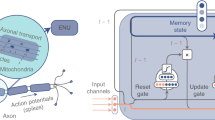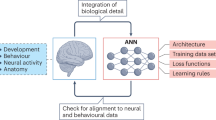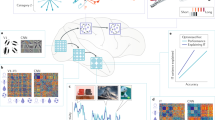Key Points
-
The development of evolutionary autonomous agents (EAA) harnesses genetic algorithms and genetic programming to evolve neurally controlled autonomous agents that perform biologically oriented tasks, such as navigation and foraging. It has significant potential as a new research tool for computational neuroscience.
-
The promise of EAA studies stems from a few important factors. The neuro-controller 'brains' that govern the agents' behaviour are emergent phenomena in a biologically relevant setting. As such, their architecture and organization are not a biased reflection of our current views and models of neural information processing. Their small size and the relative simplicity of the environments in which they evolve, coupled with the availability of full information on both the agents and their environment, make these networks amenable to functional and structural analysis.
-
The nascent field of EAA studies in neuroscience modelling still suffers from a few serious limitations, among them the inadequacy of the existing EAA methodology to generate controller network solutions to many complex behavioural tasks, and the very restricted sensors and motor models that are used in current EAA applications.
-
EAA studies have already made interesting contributions to computational-neuroscience research. These include studies that have evolved biological circuits such as central pattern generators and memory-dependent command neurons that modulate behaviour. EAAs are essential for theoretically studying the complex interactions between evolution and learning, and the principles of genetic encoding and development of neural circuits. Last, but not least, EAA models are an important conceptual vehicle for finding new ways of characterizing neural information processing and representation, and for quantitatively estimating these properties.
-
The combination of the results reviewed here, the clear challenges that await in the near future, and the continuing fast growth of computing resources, support the idea that EAAs represent a promising way of making neuroscience modelling as simple as possible, without simplifying it so much that it ceases to be useful. “As simple as possible” might turn out to be very complex, but EAA studies are still one of our best bets.
Abstract
In this article, I discuss the use of neurally driven evolutionary autonomous agents (EAAs) in neuroscientific investigations. Two fundamental questions are addressed. Can EAA studies shed new light on the structure and function of biological nervous systems? And can these studies lead to the development of new tools for neuroscientific analysis? The value and significant potential of EAA modelling in both respects is demonstrated and discussed. Although the study of EAAs for neuroscience research still faces difficult conceptual and technical challenges, it is a promising and timely endeavour.
This is a preview of subscription content, access via your institution
Access options
Subscribe to this journal
Receive 12 print issues and online access
$189.00 per year
only $15.75 per issue
Buy this article
- Purchase on Springer Link
- Instant access to full article PDF
Prices may be subject to local taxes which are calculated during checkout





Similar content being viewed by others
References
Mitchell, M. An Introduction to Genetic Algorithms (MIT Press, Cambridge, Massachusetts, 1996).
Langton, C. Artificial Life: an Overview (MIT Press, Boston, Massachusetts, 1997).
Fogel, D. B. Evolutionary Computation — Toward a New Philosophy of Machine Intelligence (IEEE Press, Piscataway, New Jersey, 1999).
Adami, C. Introduction to Artificial Life (Springer, New York, 1998).
Aharonov-Barki, R., Beker, T. & Ruppin, E. Emergence of memory-driven command neurons in evolved artificial agents. Neural Comput. 13, 691–716 (2001).This study was one of the first to evolve general, recurrent controlling networks, manifesting the spontaneous emergence of biological-like command neurons that switch between distinct behavioural modes.
Meyer, J. A. & Guillot, A. From SAB90 to SAB94: four years of animat research. Proc. 3rd Int. Conf. Simul. Adaptive Behav. (eds Cliff, D., Husbands, P., Meyer, J. A. & Wilson, S. W.) 2–11 (MIT Press, Cambridge, Massachusetts, 1994).
Kodjabachian, J. & Meyer, J. A. Evolution and development of neural controllers for locomotion, gradient-following and obstacle-avoidance in artificial insects. IEEE Trans. Neural Netw. 9, 796–812 (1998).
Yao, X. Evolving artificial neural networks. Proc. IEEE 87, 1423–1447 (1999).
Guillot, A. & Meyer, J. A. From SAB94 to SAB2000: what's new, animat? Proc. 6th Int. Conf. Simul. Adaptive Behav. (eds Meyer, J. A., Berthoz, A., Floreano, D., Roitblat, H. L. & Wilson, S. W.) 2–11 (MIT Press, Cambridge, Massachusetts, 2000).
Guillot, A. & Meyer, J. A. The animat contribution to cognitive systems research. J. Cogn. Syst. Res. 2, 157–165 (2001).
Cangelosi, A. & Parisi, D. A neural network model of Caenorhabditis elegans : the circuit of touch sensitivity. Neural Process. Lett. 6, 91–98 (1997).
Ijspeert, A. J., Hallam, J. & Willshaw, D. Evolving swimming controllers for a simulated lamprey with inspiration from neurobiology. Adaptive Behav. 7, 151–172 (1999).This paper describes an elaborate study that evolved swimming controllers, showing the power of EAAs in generating biologically relevant network models that outperform existing handcrafted ones.
Ekeberg, O. A combined neuronal and mechanical model of fish swimming. Biol. Cybern. 69, 363–374 (1993).
Jung, R., Kimmel, T. & Cohen, A. H. Dynamical behavior of a neural network model of locomotor control in the lamprey. J. Neurophysiol. 75, 1074–1086 (1996).
Edwards, D. H., Heitler, W. J. & Krasne, F. B. Fifty years of command neurons: the neurobiology of escape behavior in the crayfish. Trends Neurosci. 22, 153–161 (1999).
Xin, Y., Weiss, K. R. & Kupfermann, I. A pair of identified interneurons in Aplysia that are involved in multiple behaviors are necessary and sufficient for the arterial-shortening component of a local withdrawal reflex. J. Neurosci. 16, 4518–4528 (1996).
Nagahama, T., Weiss, K. & Kupfermann, I. Body postural muscles active during food arousal in Aplysia are modulated by diverse neurons that receive monosynaptic excitation from the neuron CPR. J. Neurophysiol. 72, 314–325 (1994).
Teyke, T., Weiss, K. & Kupfermann, I. An identified neuron (CPR) evokes neuronal responses reflecting food arousal in Aplysia. Science 247, 85–87 (1990).
Panchin, Y. V. et al. Control of locomotion in the marine mollusc Clione limacina. XI. Effects of serotonin. Exp. Brain Res. 109, 361–365 (1996).
Norris, B. J., Coleman, M. J. & Nusbaum, M. P. Recruitment of a projection neuron determines gastric mill motor pattern selection in the stomatogastric nervous system of the crab, Cancer borealis. J. Neurophysiol. 72, 1451–1463 (1994).
DiCaprio, R. A. An interneurone mediating motor programme switching in the ventilatory system of the crab. J. Exp. Biol. 154, 517–535 (1990).
Combes, D., Meyrand, P. & Simmers, J. Motor pattern specification by dual descending pathways to a lobster rhythm-generating network. J. Neurosci. 19, 3610–3619 (1999).
Brisson, M. T. & Simmers, J. Neuromodulatory inputs maintain expression of a lobster motor pattern generating network in a modulation-dependent state: evidence from long-term decentralization in vitro. J. Neurosci. 18, 2212–2225 (1998).
Husbands, P., Smith, T., Jacobi, N. & Oshea, M. Better living through chemistry: evolving GasNets for robot control. Connection Sci. 10, 185–210 (1998).
Ishiguro, A. Evolving an adaptive controller for a legged robot with dynamically-rearranging neural networks. Proc. 6th Int. Conf. Simul. Adaptive Behav. (eds Meyer, J. A., Berthoz, A., Floreano, D., Roitblat, H. L. & Wilson, S. W.) (MIT Press, Cambridge, Massachusetts, 2000).
Beer, R. D., Chiel, H. J. & Gallagher, J. C. Evolution and analysis of model CPGs for walking. II. General principles and individual variability. J. Comput. Neurosci. 7, 119–147 (1999).This paper and reference 48 show the use of EAA models as a tool for generating and analysing simple and tractable dynamic network systems, introducing the concept of dynamical modules as a computational analogue of Getting's classical dynamically varying modules.
Scheier, C., Pfiefer, R. & Kunyioshi, Y. Embedded neural networks: exploiting constraints. Neural Netw. 7–8, 1551–1569 (1998).This paper describes a set of experiments that show the importance and significance of studying neural-network controllers of agents embodied in their environment.
Beer, R. D. Dynamical approaches to cognitive science. Trends Cogn. Sci. 4, 91–99 (2000).
Nolfi, S. & Floreano, D. Learning and evolution. Auton. Robots 7, 89–113 (1999).
Hinton, G. E. & Nowlan, S. How learning can guide evolution. Complex Syst. 1, 495–502 (1987).
Miller, G. F. & Todd, P. Exploring adaptive agency. I. Theory and methods for simulating the evolution of learning. Proc. 1990 Connectionist Models Summer School (eds Touretzky, D. S., Elman, J. L., Sejnowski, T. J. & Hinton, G. E.) 65–80 (Morgan Kaufmann, San Mateo, California, 1990).
Nolfi, S. & Parisi, D. Learning to adapt to environments in evolving neural networks. Adaptive Behav. 5, 75–98 (1997).
Churchland, P. S. & Sejnowski, T. J. The Computational Brain (MIT Press, Boston, Massachusetts, 1989).
Niv, Y., Joel, D., Meilijson, I. & Ruppin, E. Evolution of reinforcement learning in foraging bees in neural terms. 10th Annu. Comput. Neurosci. Meet. CNS2001 (Monterey, California, 2001). Neurocomputing (in the press).
Montague, P. R., Dayan, P., Person, C. & Sejnowski, T. J. Bee foraging in uncertain environments using predictive Hebbian learning. Nature 377, 725–728 (1995).
Schacher, S., Wu, F. & Sun, Z.-Y. Pathway-specific synaptic plasticity: activity-dependent enhancement and suppression of long-term heterosynaptic facilitation at converging inputs on a single target. J. Neurosci. 17, 597–606 (1997).
Vogt, K. E. & Nicoll, R. E. Glutamate and γ-aminobutyric acid mediate a heterosynaptic depression at mossy fiber synapses in the hippocampus. Proc. Natl Acad. Sci. USA 96, 1118–1122 (1999).
Fisken, R., Garey, L. & Powell, T. Patterns of degeneration after intrinsic lesions of the visual cortex of the monkey. Brain Res. 53, 208–213 (1973).
Hess, R., Negishi, K. & Creutzfeldt, O. The horizontal spread of intracortical inhibition in visual cortex. Exp. Brain Res. 22, 415–419 (1975).
Douglas, R. & Martin, K. in The Synaptic Organization of the Brain (ed. Shepherd, G. M.) 389–438 (Oxford Univ. Press, Oxford, 1997).
Reggia, J., Autrechy, L., Sutton, G. & Weinrich, M. A competitive distribution theory of neocortical dynamics. Neural Comput. 4, 287–317 (1992).
Mountcastle, V. Perceptual Neuroscience: Cerebral Cortex (Harvard Univ Press, Boston, Massachusetts, 1998).
Ayers, D. & Reggia, J. A. Evolving columnar circuitry for lateral cortical inhibition. Proc. INNS–IEEE Int. Joint Conf. Neural Netw. 278–283 (IEEE Press, Washington DC, 2001).Going beyond EAAs, this study shows the power of evolutionary computation to search for candidate cortical columnar architectures that might best subserve observed patterns of cortical activity.
Rolls, E. T. & Stringer, S. M. On the design of neural networks in the brain by genetic algorithms. Prog. Neurobiol. 61, 557–579 (2000).
Dellaert, F. & Beer, R. D. Toward an evolvable model of development for autonomous agent synthesis. Proc. 4th Conf. Artif. Life (eds Brooks. R. & Maes, P.) 246–257 (MIT Press, Cambridge, Massachusetts, 1994).
Floreano, D. & Urzelai, J. Neural morphogenesis, synaptic plasticity and evolution. Theory Biosci. 120, 223–238 (2001).
Cliff, D. & Miller, G. F. Co-evolution of pursuit and evasion. II: Simulation methods and results. Proc. 4th Int. Conf. Simul. Adaptive Behav. (eds Maes, P. et al.) 506–515 (MIT Press, Cambridge, Massachusetts, 1996).
Chiel, H. J., Beer, R. D. & Gallagher, J. C. Evolution and analysis of model CPGs for walking. I. Dynamical modules. J. Comput. Neurosci. 7, 99–118 (1999).
Getting, P. Emerging principles governing the operations of neural networks. Annu. Rev. Neurosci. 12, 185–204 (1989).
Marder, E. & Calabrese, R. L. Principles of rhythmic motor pattern generation. Physiol. Rev. 76, 687–717 (1996).
Marder, E. & Abbott, L. F. Theory in motion. Curr. Opin. Neurobiol. 5, 832–840 (1995).
Dumont, J. P. C. & Robertson, R. M. Neuronal circuits: an evolutionary perspective. Science 233, 849–853 (1986).
Floreano, D. & Mondada, F. Evolution of homing navigation in a real mobile robot. IEEE Trans. Syst. Man Cybern. B 26, 396–407 (1996).
Harvey, I., Husbands, P. & Cliff, D. Seeing the light: artificial evolution, real vision. Proc. 3rd Int. Conf. Simul. Adaptive Behav. (eds Cliff, D., Husbands, P., Meyer, J. A. & Wilson, S. W.) 392–401 (MIT Press, Cambridge, Massachusetts, 1994).
Stanley, K. O. & Miikkulainen, R. Evolving neural networks through augmenting topologies. Technical Report No. AI01-290 〈http://citeseer.nj.nec.com/stanley01evolving.html〉 (University of Texas at Austin, 2001).
Aharonov, R., Meilijson, I. & Ruppin, E. in Advances in Neural Information Processing Systems Vol. 13 (eds Leen, T. K., Dietterich, T. G. & Volker, T.) 3–9 (MIT Press, Boston, Massachusetts, 2001).This paper uses the EAA paradigm to develop a new functional-contribution analysis method, which assesses how different behavioural tasks are localized and represented across a controller network.
Wu, J., Cohen, L. B. & Falk, C. X. Neuronal activity during different behaviors in Aplysia: a distributed organization? Science 263, 820–822 (1994).
Thorpe, S. in The Handbook of Brain Theory and Neural Networks (ed. Arbib, M. A.) 549–553 (MIT Press, Boston, Massachusetts, 1995).
Lashley, K. S. Brain Mechanisms in Intelligence (Univ. Chicago Press, Chicago, 1929).
Lomber, S. G. The advantages and limitations of permanent or reversible deactivation techniques in the assessment of neural function. J. Neurosci. Methods 86, 109–117 (1999).
Walsh, V. & Cowey, A. Transcranial magnetic stimulation and cognitive neuroscience. Nature Rev. Neurosci. 1, 73–79 (2000).
Friston, K. J., Frith, C. D. & Frackowiak, R. S. J. Time-dependent changes in effective connectivity measured with PET. Hum. Brain Imaging 1, 69–79 (1993).
Braitenberg, V. Vehicles, Experiments in Synthetic Psychology (MIT Press, Cambridge, Massachusetts, 1984).
Marr, D. Vision (W. H. Freeman, New York, 1982).
Brooks, R. A. Intelligence without representations. Artif. Intell. 47, 139–159 (1991).
Cliff, D. & Noble, S. Knowledge-based vision and simple visual machines. Phil. Trans. R. Soc. Lond. B 352, 1165–1175 (1997).This paper reviews a series of EAA studies of visual processing to conclude that this task is performed in a distributed, complex manner that is fundamentally different from the top–down, hierarchical processing used in classical computational/engineering approaches.
Cliff, D. in The Handbook of Brain Theory and Neural Networks (ed. Arbib, M. A.) 626–631 (MIT Press, Boston, Massachusetts, 1995). | PubMed |
Kitano, H. Designing neural networks using genetic algorithms with graph generation system. Complex Syst. 4, 461–476 (1990).
Gruau, F. Automatic definition of modular neural networks. Adaptive Behav. 3, 151–183 (1994).This paper presents graph grammar phenotype-to-genotype encodings that achieve highly compact encodings, leading to modular network architectures.
Kodjabachian, J. & Meyer, J. A. Evolution and development of modular control architectures for 1-D locomotion in six-legged animats. Connect. Sci. 10, 211–254 (1998).
Zhang, B.-T. & Muhlenbein, H. Evolving optimal neural networks using genetic algorithms with Occam's razor. Complex Syst. 7, 199–220 (1993).
Belew, R. K. in Advances in Neural Information Processing (NIPS5) (ed. Cowan, J.) 99–106 (Morgan Kaufmann, San Mateo, California, 1993).
Cangelosi, A., Parisi, D. & Nolfi, S. Cell division and migration in a 'genotype' for neural networks. Network 5, 497–515 (1994).This paper was one of the first to study biologically inspired 'developmental' encodings that are based on a genetic program composed of steps such as cell division and axonal growth. This lays the foundations for more detailed 'regulatory' encodings, in which the identity of the expressed gene subset is determined by interacting transcription factors.
Nolfi, S. & Parisi, D. Evolving artificial neural networks that develop in time. Eur. Conf. Artif. Life 353–367 (Springer, Berlin, 1995).This is one of a series of papers that exploit the potential of EAA models to study the interesting and complex interactions between learning and evolution (originally cast in the Baldwin effect).
Cangelosi, A. & Elman, J. L. Gene regulation and biological development in neural networks: an exploratory model. Technical Report No. CRL–UCSD 〈http://www.citeseer.nj.nec.com/context/15377/132530〉 (University of California at San Diego, 1995).
Eggenberger, P. Cell interactions as a control tool of developmental processes for evolutionary robotics. Proc. 4th Int. Conf. Simul. Adaptive Behav. (eds Maes, P. et al.) 440–448 (MIT Press, Cambridge, Massachusetts, 1996).
Floreano, D. & Urzelai, J. Evolutionary robots with online self-organization and behavioral fitness. Neural Netw. 13, 431–443 (2000).This paper explores the evolution of EAA neurocontrollers through learning in a self-organizing manner without any specification of a set of inherited initial synaptic weights.
Rust, A. G., Adams, R., George, S. & Bolouri, H. Activity-based pruning in developmental artificial neural networks. Proc. 4th Eur. Conf. Artif. Life (ECAL 97) (eds Husbands, P. & Harvey, I.) 224–233 (MIT Press, Cambridge, Massachusetts, 1997).
Acknowledgements
Supported by the FIRST grant of the Israeli Academy of Sciences, and the Adams Brain Centre, Tel-Aviv University. I thank R. Aharonov, T. Beker, N. Gal-Ruppin, D. Horn, I. Meilijson, Y. Niv, Y. Oron, J. A. Reggia and Z. Solan for careful reading of this manuscript and many helpful comments.
Author information
Authors and Affiliations
Related links
Glossary
- EVOLUTIONARY COMPUTATION
-
A computational paradigm that is based on searching the space of possible solutions to a problem by selectively creating new solutions from the best obtained so far.
- EMBODIED AGENTS
-
Agents whose fitness is determined by an interaction with the environment in which they live, given a set of sensors and motors, and a controlling network that mediates between the two.
- ARTIFICIAL NEURAL NETWORK
-
A computational model, the architecture of which is modelled after the brain. They contain idealized neurons called nodes, which are connected together in a network.
- GENETIC ALGORITHM
-
One of the main ways of performing evolutionary computing, based on generating new solutions from existing ones by applying to them genetically inspired operations, such as mutations and crossover. In most cases, the genotype (in which variation takes place) is different from the phenotype (in which fitness-dependent selection take place).
- ANIMATS
-
Artificial embodied agents.
- GENOTYPE-TO-PHENOTYPE ENCODING
-
A mapping (transformation) that specifies the phenotype(s) created from a given genotype.
- ANIMATES
-
Biological embodied agents.
Rights and permissions
About this article
Cite this article
Ruppin, E. Evolutionary autonomous agents: A neuroscience perspective. Nat Rev Neurosci 3, 132–141 (2002). https://doi.org/10.1038/nrn729
Issue Date:
DOI: https://doi.org/10.1038/nrn729
This article is cited by
-
Evolutionary autonomous agents and the naturalization of phenomenology
Phenomenology and the Cognitive Sciences (2006)



